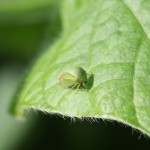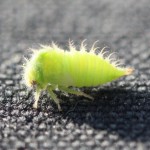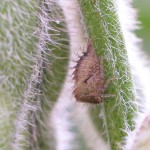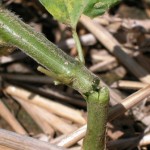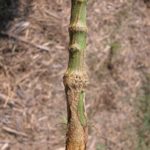Although not a major pest, the threecornered alfalfa hopper (TCAH) causes occasional damage by girdling the main stems of seedling plants (typically those < 10 inches tall). They will feed around the perimeter of the stem with their beak, eventually creating a swollen callus. By itself, this injury does not affect yield, but girdled plants may lodge (snap) at the point of the girdle. This may occur soon after feeding, and you may notice plants snap over as you walk through a field, or it may happen weeks later. I often get calls after a wind storm. Because of our mild winter, and the fact that Tennessee is on the northern edge of the TCAH range, populations appear higher than normal this year.
Soybeans can tolerate a fair amount of girdling because most plants will not lodge. However, high populations of TCAH on seedling soybean can reduce stands and yield. Economic damage is almost always restricted to no-till fields and is often worse around field edges. Infestations are generally higher in late planted soybean. My experience is that economic damage is more likely to occur when plant populations are thin to begin with, partly because where stands are thin, there are fewer neighbors to compensate for the lodging of some plants, but also because plants are less likely to lodge in thicker stands because their neighbors provide support.
Scouting: The moral of this story is to scout seedling soybean for TCAH and be especially alert in late-planted, no-till fields where stands are already less than ideal. I’ve included some photos of this insect below. There is no well-established threshold for TCAH in seedling soybean but there are a couple of tips to help you determine if treatment is necessary.
- Treat if 10 percent of young plants (up to 10-12 inches) are infested with adults or nymphs. To be honest, this is laborious and requires time on your hands in knees.
- You can also visually inspect stems for girdling. You can bend small plants over with a yardstick or sweep net handle to check for girdling (plants often snap over as you do this). Just remember that this is scouting for past damage, and revenge treatments are a waste of money if plants are already past the susceptible stage.
- Keep your eyes and ears open for adults “popping” around as you walk through fields. Because adults will hop when disturbed, it may sound a little like popcorn popping as you walk through wheat-beans.
- What I really like to do is gently sweep small plants. It may seem awkward, but you can sweep plants that are 3-4 inches tall (although it’s more difficult in wheat stubble). This will give you a relative idea of how many are present … best guess is that 30+ per 100 sweeps would be of some concern in the scenario described above where stands are thin to begin with.
Treatment: Insecticide seed treatments provide some projection, but some injury may still be observed and it can be common along field perimeters or in small fields because TCAH are infesting from the edges.
- Foliar insecticides such as synthetic pyrethroids, acephate, or chlorpyrifos (e.g., Lorsban) will typically provide good control. Reinfestation can occur quickly, but keep in minds that the seedling plants are rapidly becoming less susceptible as they grow. Multiple insecticide application are generally not advised. Recommended insecticides and rates are available here.
- Recent research as indicated that infestations in soybean after R1 will not affect yield. My experience is that most serious damage occurs before plants are 6-8 inches tall, Treatment is not generally recommended for plants greater than 12 inches tall.

